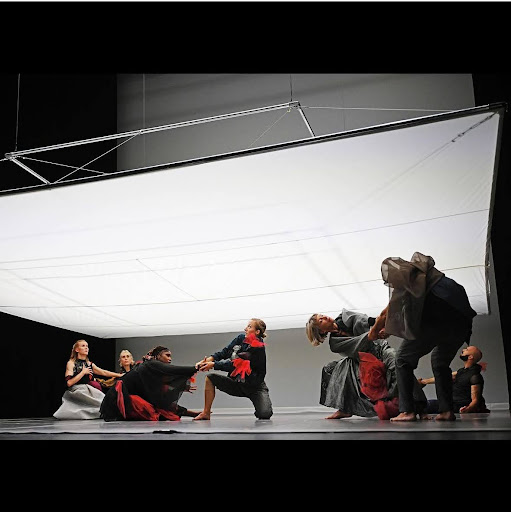Courtesy of Sean Elliot
My ticket reads “Saturday, October 26.” Audiences pack Palmer Auditorium, eagerly anticipating the onset of audio as darkness fills the room. Instead, a sleepy David Dorfman claws his way out from under a pile of fabric, yawning and shifting his gaze to fellow dancer Lisa Race’s entrance to the spotlight. Remaining company members line up behind the pair, meeting the floor with tops of heads in a teaser to the display of agility yet to come. Leveraged against Dorfman’s near-vertical stance, Race shoots upside down, holding the pose for a brief moment of calm. “Thud!” Dorfman and Race artfully collapse. “Chapter 1: The Battle,” declares an ominous voice. “Tsk-t-t-ta-tsk-t-t-t-tsk-t-t-t-t” begins the hum of audio, a catchy tune impossible to clear from one’s brain. War is declared.
Just in time for the 2024 election, David Dorfman Dance Company—Connecticut College’s very own company-in-residence—premiered “Truce Songs” on the Connecticut College campus, sharing yet another impactful example of how movement may be blended with social commentary to facilitate dialogue on 21st century society. “This started with the notion of truce with self. The first thing that I did [was] a little song, little dance, and then I called it “Truce With Self, First Attempt,” company founder, choreographer, and Connecticut College professor David Dorfman revealed in a post-performance Q&A session. “…we have struggled. Is [this work] about war? This last period of research has been more about [how] it’s personal truce. Even though we have a text that’s called ‘War’…I just want to reflect on how we can find ourselves through turbulent times and be intimate with one another.”
Performers certainly presented as physiologically familiar with each individual’s abilities whilst on stage, executing an array of energetic, multi-level duets and synchronic group numbers over the duration of “Chapter One.” Feats of rapid weight sharing, trust-driven tricks, and forceful yet soft movement appeared almost easy to the casual eye, flawlessly carried out in an emotionally expressive, rhythmically satisfying manner. Attendees watched show tension build with baited breath, captivated by what Dorfman characterized as how “We’re bodily fighting, we’re bodily holding–keeping people at bay, but also really being dependent. When you lift another person, when they swing their leg over you two inches from your temples, that is trust, and that’s another kind of kinetic intimacy and kinetic empathy at the same time…it’s about really risking your bodies with each other, and so that can be like almost a pleasant fight.”
“Chapter 2: The Players,” announces the loudspeaker. Viewers have just about reached the halfway point of David Dorfman Dance Company’s “Truce Songs,” marking a transition from raw motion to comedic role play on topics including “the wind,” and “the interru”—sorry, where was I? Company member Nik Owens played the role of the “waiter,” otherwise known as the “one who waits.” Unfortunately, patrons will have to “wait” to find out who or what this dancer is in perpetual anticipation of. Regarding the laborious interpretation of this title, I would assume any food ordered from Owens’s character may not be served in the near future.
Following a length of humor, dynamic maneuvers, and loaded silence, the third and final chapter of “Truce Songs” concluded with a supersized white flag attached to a metal, square-shaped rim. This descending set piece enveloped company members, who were slowly pushed closer and closer to the ground until forced to lay flat. Dancers then proceeded to army crawl to the object’s borders before each tied a costume piece around the four silver edges. Spectators and onstage artists alike watched as dangling clothing launched into the air, accompanying the literal and metaphorical rise of the symbol of truce—and an invitation to conversation all but guaranteed to extend long beyond the company’s two hours at Connecticut College. In the words of Dorfman, “[Truce] is a synthetic creation. You decide, let’s have a truce for a religious holiday, or for a weekend, and then sometimes you extend it. If you can make something up like that, why can’t you make it up to last longer?”
Prior to the performance, attendees were gifted a small white square of cloth to keep as a tactile reminder of the night’s events. “I like giving presents to the audience—it’s kind of like a party favor in a certain way—and also something where you can leave the theater with something other than a program and maybe think about it, and have a texture and a palpable,” Dorfman shared. “You know, it’s funny. We’re in Pfizer country around here…I think [Pfizer has] some kind of custom where you put a…fake gold coin on somebody’s desk if you want to have an honest talk with them … and so I thought: what if this little thing—you could think of it as surrender or you could think of it as a blossoming or an opportunity or a caring.”
David Dorfman Dance Company waved the white flag. Now it’s up to audiences to choose where to lay down arms next. After all, “Someone’s got to take a chance and lead in a different way. Maybe that way is surrender first.”









